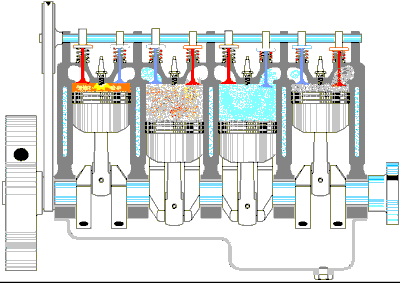Most of us know the agony of having your car break down in the middle of nowhere or on the way to work. You have gone through it and so have I, and let me tell you it was one painful and long day. However, an auto repair shop was nearby and that sort of came to the rescue. I say ’sort of’ because for basic auto repair they charged me a bundle. Not many will tell you this but as important as knowing a family doctor is, I feel it is equally important to know professional auto repair services.
Now, I am not suggesting you start building new relationships immediately, but you definitely need to know the basics on the mechanism, and working of your automobile. Listed below are necessary pointers, to give you an idea of the basics of car care and maintenance, that will boost and improve your auto repair IQ while also helping you make better choices about your car.
* Synthetic Oil is just a poorer alternative and not always better. If your car has been functioning smoothly with regular oil, and your car’s manual doesnt suggest a change, stick to regular oil for all your oil change requirements. The main reason why auto shops ask you to change is to only make quick money.
* Get a new timing belt on recommended intervals. A timing belt does not have warnings or symptoms but when it breaks, and depending on the kind of engine your car runs on, it can cause substantial internal wreckage. This results in your car’s pistons crashing into valves.
* While changing your timing belt, switch your serpentine belt or drive belts too as it can save all your future labor charges. Serpentine or drive belts should be taken out in order to complete the timing belt’s replacement.
* Want long lasting and long performing windshield wipers? Use alcohol and a soft rag while cleaning your windshield wipers to improve its performance and also to extend its life.
* Know how to check all the fluid levels in your car Engine coolant, engine oil, power steering fluid, transmission fluid, washer solvent and brake fluid, all show fluid levels. An indicator of forthcoming problems is dropping fluid levels.
* Regularly check your brake pad’s life. Switch the pads before they are exhausted and begin to grind into your vehicle’s brake rotors which will further increase price of brake repair.
* Always clean your car’s battery posts.
* Know that every different automobile has a different duration for the change of the cars spark plugs. Read your vehicles manual to know about your cars interval time. To make extra money, deceitful auto mechanics may suggest switching spark plugs after every 30,000 miles even if your car’s spark plugs’ life expectancy may be 100,000 miles.
* Check the pressure of your tires frequently. If your tyres are inflated to the right pressure, it saves fuel and also lengthens the tire longevity. On the other hand, lessening tyre air pressure means a leak that needs immediate repair.
* Regularly check your air filters. Filthy air filters reduce fuel economy and functioning. A high-pressure hose can be used to blow-out dirty air filters instead of getting new ones.
* Keep an eye on your engine oil. Check your engine oil regularly. Older automobiles may start to burn oil. Sometimes, cars can run dangerously low on engine oil and not show any warning of a leak.
To be realistic, many of us will never make efforts to learn how to work on our own cars. Most of the cars that came out within the last decade are run by a variety of electronic sensors and computers. The positive bit about this is that the auto industry is always making changes to improve fuel economy, lessen pollution, and provide optimum performance all by itself. On the other hand, vehicles need regular specialized training, and exorbitant testing equipments in order to flawlessly determine problems and repair cars.
Without this necessary training and contribution in specialized car tools, the DIY car owner, (and even smaller auto repair shops) has no other option but to throw parts at cars until the warning signs disappear. In some situations, auto shops replace a certain part, and later also suggest after the installation that another part too requires changing. If it was never mentioned in the beginning, this is an alarm bell that the mechanic isnt accomplished enough to recognize the problem effectively. With a bad mechanic, you might have just replaced parts that were working perfectly well.
This is the main reason we state that the most crucial choice you make in getting your car fixed is which auto repair shop you take your car to. As many honest and skilled mechanics there are, also present are deceptive and dishonest mechanics too. We suggest you ask your friends and neighbors to recommend you a mechanic, else use a 3rd party service like AAA, the Better Business Bureau, or CompareAutoCare.com to provide you with information on shops in your local area, so that you have an idea of what youre stepping into before you actually bring in your vehicle for service.
Mostly, enjoy your ride.
Author: Curry Jasper
Article Source: EzineArticles.com





